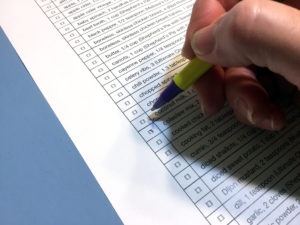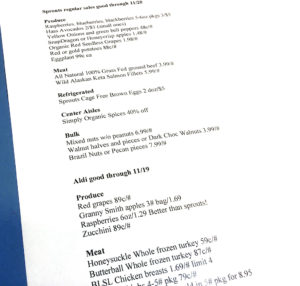Every store has loss leaders…“deals” meant to entice you into their store instead of others. But often, stores are clustered close to one another. Why not use this opportunity to make the most out of your shopping dollars?
I typically spend $100-$125 per week on food for our family of 3-4 (just depends on who’s home when). This is mostly whole food ingredients for home-cooked meals…not cheap processed foods or higher priced organics.
And yes, I do shop 4 different stores each Saturday. Most people are astonished when I say this. They counter with “I could never do that.” I didn’t think I could either until I got smart. I figured out I could buy the loss leaders at every store and save even more!
Just like any skill worth having, this takes practice. Don’t shake your head at me until you try it a couple of times yourself. You may have stores grouped in a cluster near your home. Or maybe there’s a cluster near work or other businesses you frequent. I have all four within a mile of each other by my office. It’s easy to get in the habit of whipping in and out of all four when they’re so close together. Yes, this could be challenging with children in tow so tailor to your own needs certainly!
Steps to maximum grocery savings

- Print shopping list from my MacGourmet software. I have several weeks worth of menu plans already in there so I just go to the appropriate week. More on menu planning here.
- Identify what things I need by checking my shopping list against my inventory.
- Print specials list. I pull together a list from the sales flyers each week…if you live in the Middle TN area and would like to get that email, request it through missmellie@missmelliecooks.com.

- Check my “needs” from the shopping list against the specials list deciding where I want to get each item. Not all will be on sale of course. But I know my stores’ regular prices well enough to know who has what cheapest.
- Transfer the things I’ve noted I need (or want to get for later) and their prices to a list for each store separated by sections (Produce, meat, center aisles, frozen, misc).
- Add anything I noted during the week that I was needing (like baggies when I used the last one!)
- Add up the total for each store. I put this in a little spot on the bottom where I can total it all up and then record what I actually spent.

Having the items separated by section helps you get everything you need without forgetting a fruit because it was listed in with meats.
The goal is to set your budget for the week and use those totals to stick to it. (Occasionally a good meat sale puts you over the mark then cuts back your costs later on…check out more on knowing how much meat you need to buy when here and bulk buying here!)
You may end up not finding the sale item you wanted at one store and getting it somewhere else, but at least you have a good framework for keeping to your budget.
It takes some practice and time to get this all together, but I promise you it can pay off in a big way! Planning ahead and using a “loss leader” strategy can definitely help you make the most of your shopping dollars!

